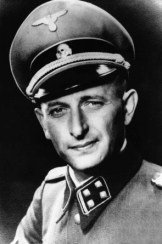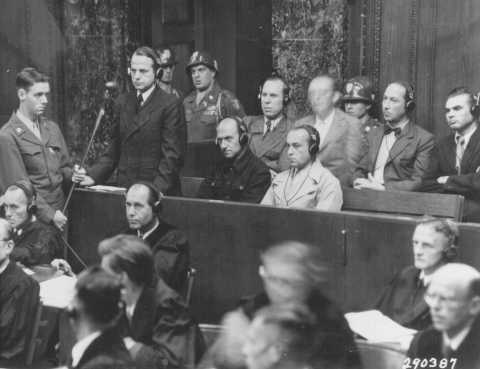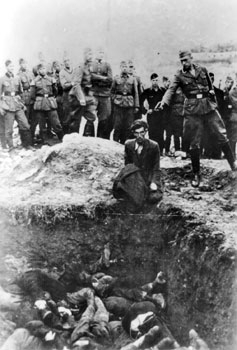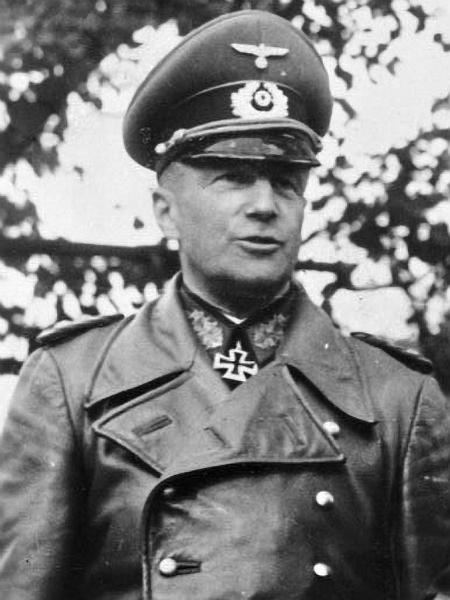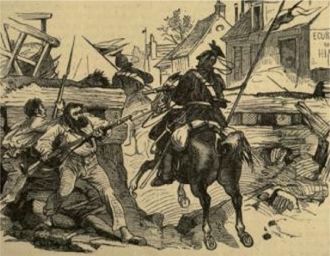Friends of Padre Steve’s World,
This is another part of series of articles on the actions of Hitler’s SS and their Einsatzgruppen during their campaign of mass murder in Eastern Europe. This section is about the campaign in Russia. It is even more troubling than the previous sections, because in Russia, all pretense of civilization was dropped and even the German Army was heavily engaged in committing some of the most heinous and evil atrocities ever committed by a supposedly civilized and allegedly Christian people.
Likewise, it is important to remember that much of what happened before February 1942 occurred before the decision to implement the Final Solution and the beginning operations of the massive extermination camps such as Auschwitz-Birkenau, Soribor, Belzec, and Treblinka in Poland. The latter three were simply extermination centers, while Auschwitz-Birkenau served a multiplicity of roles: death camp, medical experimentation center, work camp which provided laborers for German industry, and camp for Polish political dissidents. I will deal with these camps in future articles.
The tragedy is that other nations and people’s including Americans, British, French and the Belgians, as well as the Spanish, not to mention the Russians, Chinese, Turks, Japanese, Rwandans, and so many other have committed genocide, but nothing in their litany of genocide can compare with the Nazi Holocaust, even when the numbers added up to more. This is because nearly every ministry of the German Government was involved in them, and the Nazi Party, its officials, German Government ministries, the military and police, and German industry were involved to an extent not seen before or since.
The leaders of the Einsatzgruppen were according to General Telford Taylor:
“These defendants are not German peasants or artisans drafted into the Wehrmacht. They are not uneducated juveniles. They are lawyers, teachers, artists, and a former clergyman. They are, in short, men of education, who were in full possession of their faculties and who fully understood the grave and sinister significance of the program they embarked upon. They were part of the hard core of the SS. They did not give mere lip service to Himmler’s atrocious racial doctrines; they were chosen for this terrible assignment because they were thought to be men of sufficient ruthlessness to carry them out. They are hand-picked fanatics; every one of them was an officer of the SS … They are not unhappy victims, unwillingly pushed into crime by the tyranny of the Third Reich; these men, above all others, themselves, spread the Nazi doctrine with fire and sword.” (From “The Eichmann Kommandos: Hitler’s Executioners and the Einsatzgruppen Trial” by Justice Michael Musmanno, 1964)
Had not files been unearthed in the ruins of Berlin by a young Jewish American investigator, Benjamin Ferencz, the crimes of the Einsatzgruppen might never had been uncovered, or their leaders tried. Ferencz reported back to his superior Brigadier General Telford Taylor that he had evidence that another trial had to be added to the Nuremberg trials. Taylor agreed, and Ferencz, the youngest member of the prosecution team was appointed to prosecute these men, although he had never tried a case in his life.

Benjamin Ferencz Prosecuting the Accused during the Einsatzgruppen Trial, Ferencz is the last surviving prosecutor or defense attorney from the Nuremberg Trials still living, he was a driving force in the establishment of the International Criminal Court, which the United States has yet to Join.
The actions of the Nazis, if they were simply limited to just the Germans of that period could be explained away as a exception, but it is not. That is what makes these heinous crimes so troubling, as the people who committed them were not that different than us, or our own ancestors. Despite those the genocides perpetrated by others, those of the Nazis against the Jews are unique in their execution and evil. The entire police and military power of a nation were used first against their fellow citizens, and then against the Jews of every country they conquered or occupied in Europe. It was unique and thus the evil perpetrated by them was in a league of its own.
Eventually I will be revising these articles significantly and use them in a book that I have already begun to write “Walk, Remember, Bear Witness: Ensuring the Holocaust is not Forgotten after the Last Survivors and Witnesses Have Passed Away” This revision includes minor updates to grammar as well as to clarifying what was written in earlier editions which can be found on this site. All of these revised articles will need to be converted into a word document that I can edit and add new material and update footnotes and references.
Peace
Padre Steve+
The Nazi war against Russia was the ultimate test of Hitler’s ideological race war. Planning for the war with the Soviet Union began after the fall of France and during the opening stages of the Battle of Britain, when German and the Soviet Union were supposedly committed to their non-Aggression Pact, signed just before the invasion of Poland. On 21 July 1940 Hitler made“his intentions plain” to the Army leadership of his desire to invade and destroy the Soviet Union, and the head of the OKH, Field Marshal “von Brauchitsch set his planners to work.” 119 Accordingly his staff at OKH began preparations for the offensive in the winter of 1940-41 following the Luftwaffe’s failure against Britain and postponement of Operation Sea Lion, the proposed invasion of Great Britain.
A war on multiple fronts was what all senior German officers feared, and the fact that Britain was still in the war and had opened yet another front in the Middle East against Italy which required German troops to keep the Italians from collapsing, Hitler decided to open another front. He announced his intention to “crush Soviet Russia in a quick campaign which was to begin no later than March 15, 1941, and before the end of the war with England.” 120 Field Marshal Keitel noted the final decision came in “early December 1940” and from then he had “no doubt whatsoever that only some unforeseen circumstance could possibly alter his decision to attack.” 121
The military plan initially focused on the destruction of “the Red Army rather than on any specific terrain or political objective,” 122although the political and geographic objectives would arise in later planning and during the campaign, the goal of destroying the Red Army was of paramount importance to the destruction of the Soviet Union. Hitler stated: “What matters is that Bolshevism must be exterminated. In case of necessity, we shall renew our advance whenever a new center of resistance is formed. Moscow as the center of doctrine must disappear from the earth’s center….” 123
Besides preparations aimed at the destruction of the Red Army and overthrow of the Soviet State, versus territorial gain, the “war against the Soviet Union was more openly ideological from the start.” 124 The ideological prominence set the stage for the invasion and on March 3rd 1941 Hitler announced this to his assembled Generals by announcing:
“the forthcoming campaign is more than a mere armed conflict; it is a collision between two different ideologies…this war will not be ended merely by the defeat of the enemy armed forces” and that “the Jewish-Bolshevist intelligentsia must be eliminated….” 125
Ordungspolizei Officers in Russia
The Jews remained the primary target of Hitler since he saw Jews and Bolsheviks as one. Because that was so important to him personally he realized that the task of eliminating the Jews was one that had to be conducted by Heinrich Himmler’s SS. He noted, that “this is a task so difficult that it cannot be entrusted to the Army.” 126
Reichskommissars, civilian overlords from the Nazi Party political leadership, mostly those with experience as Gauleiters would be appointed to administer conquered areas. However, since normal civilian powers would be insufficient to eliminate the Bolsheviks Hitler noted that it “might be necessary “to establish organs of the Reichsfuhrer SS alongside the army’s Secret Field Police, even in the operational areas….” 127 The “primary task” of the SS Einsatzgruppen and Police battalions was to liquidate “all Bolshevist leaders or commissars” if possible while still in the operations zones,” 128 yet the orders were vague enough not to offend the sensibilities of Army leaders and did not contain “a syllable that in practice every Jew would be handed over to the extermination machine.” 129

Wehrmacht Soldiers (not SS or Police) hanging civilians in Russia
As with almost all German operations which involved cooperation between the Army and the SS, the parties ensured very precise legal definitions and that existing agreements between the agencies, German laws, and army doctrine were followed. On 13 March an agreement was reached between the Army represented by General Wagner and the SS represented by SS-Brigadeführer Walter Schellenberg which stated in part, that “the Reichsführer SS has been given by the Führer special tasks within the operations zone of the Army…to settle the conflict between two opposing political systems.” 130Likewise the agreement dictated that Himmler’s SS units would “act independently and on his own responsibility” while ensuring that “military operations are not affected by measures necessary to carry out his task.” 131
Rounding up Jews in Russia
A further instruction was issued by Wagner on 26 March which gave the Army’s agreement for the use of the Einsatzgrüppen in the operations zone. The agreement spelled out the coordinating instructions between the Einsatzgruppen and army authorities in the operational zone and communications zones to the rear. Cooperation between the Army and the SS was based on already existing agreements between the SS and the Army, notably the “principals for co-operation between the State Secret Police and the Field Security organization of the Wehrmacht agreed with the Security branch of the War Ministry on 1 January 1937.” 132

Zentralbild – IML / 1.8.1962 II.Weltkrieg 1939-45 Der überlebende halbwüchsige Sohn dieser ermordeten Familie wird an die Mordstelle herangeführt. Von dem hinter ihm stehenden faschistischen deutschen Offizier wurde er durch Genickschuss ermordet. (The surviving teenage son of this murdered family is brought to the scene of the murder. He was murdered by a shot in the neck by the fascist German officer standing behind him.) 5.7.1941 in Slorow, Ukraine A 0706/18/30
The most significant agreement that the Army reached with the SS was the Commissar Order. This order, sometimes known as the “Criminal Order” was used war as evidence at Nuremberg as against Keitel, Jodl and High Command of the Wehrmacht during the later Generals Trial. The order specified that the Army would cooperate with the SS and kill Soviet Political Commissars attached to the Red Army who were taken prisoner, as “they were not prisoners of war.” Another order specified that “in the event that a German soldier committed against civilians or prisoners, disciplinary action was optional….” 133
This was a major break that the Wehrmacht made with its previous commitment to abide by the provisions of the Geneva and Hague Conventions. The new order noted a new attitude regarding political commissars and their protections under international law: “in this struggle consideration and respect for international law with regard to these elements is wrong.” 134 Yet another new order released by Keitel’s OKW, the Army’s “Guidelines for the Conduct of Troops in Russia” issued on May 19, 1941 called for “ruthless and vigorous measures against Bolshevist inciters, saboteurs [and] Jews.” 135 The inclusion of the Jews made the Wehrmacht a willing accomplice to every charge leveled against German political and government organizations at Nuremberg.

Jewish Women Being Finished off In Russia
Shortly before the Commissar Order was issued Hitler previewed it to the generals saying that the war in Russia “cannot be conducted in a knightly fashion” and that the war against the Soviet Union would have to be waged with “unprecedented, unmerciful and unrelenting harshness…” 136
Hitler told the generals that they would have to “dispense with all of their outdated and traditional ideas about chivalry and the generally accepted rules of warfare: the Bolsheviks had long since dispensed with them.” 137 He explained that he understood that his orders were beyond their comprehension but insisted, “I cannot and will not change my orders and I insist that that they be carried out with unquestioning and unconditional obedience.” 138
General Franz Halder, Chief of the OKH, or the Army High Command took notes on Hitler’s speech. The notes are chilling to read as none of the Generals present could have understood them in any other way than Hitler meant them:
“Clash of two ideologies. Crushing denunciation of Bolshevism, identified with asocial criminality….We must forget the comradeship between soldiers. A Communist is no comrade before nor after the battle. This is a war of extermination….We do not wage war to preserve the enemy….War against Russia: Extermination of the Bolshevist Commissars and of the Communist intelligentsia….this is no job for military courts. The individual troop commanders must know the issues at stake. They must be leaders in the fight….This war will be very different from war in the West. In the East harshness today means leniency in the future. Commanders must make the sacrifice of overcoming their personal scruples.”139
Colonel General Franz Halder, Chief Of OKH
According to Von Brauchitsch a number of Generals protested the orders that Hitler was previewing in the briefing, and demanded that he take their protest to Hitler. 140 Von Brauchitsch refused to protest the order directly or otherwise bring it up to Hitler, but issued an order on his own authority “threatening dire penalties for excesses against civilians and prisoners of war” which he maintained at Nuremberg “was sufficient to nullify the Commissar Order.” 141
But that was a lie, as during the campaign against the Soviet Union, von Brauchitsch told his commanders to “proceed with the necessary hardness.” 142 General Walter Warlimont noted that Field Marshal Fedor von Bock, who would “later emerge as an opponent of the Commissar Order…makes no special comment on the meeting or the restricted conference that followed.”143
At Nuremberg Keitel said that he “stubbornly contested” the clause “relating to the authority of the SS-Reichsführer… in the rearward operational areas.” 144
At Nuremberg Keitel attempted to shift blame for order the to the Army High Command OKH under Halder. But his argument was easy to disprove because the order came out with his signature on behalf of Hitler, which was key evidence against him at Nuremberg. Keitel stated that “there was never any possibility of justifying them in retrospect by circumstances obtaining in the Russian campaign.” 145
Some Wehrmacht commanders refused to publish the orders and “insisted that the Wehrmacht never implemented such policies…” blaming them instead on the SS, but in the campaign such refusals to publish the orders made little difference. One writer stated that “such protests were undoubtedly sincere, but in practice German soldiers were far from innocent. The senior professional officers were often out of touch with their subordinates.” 146
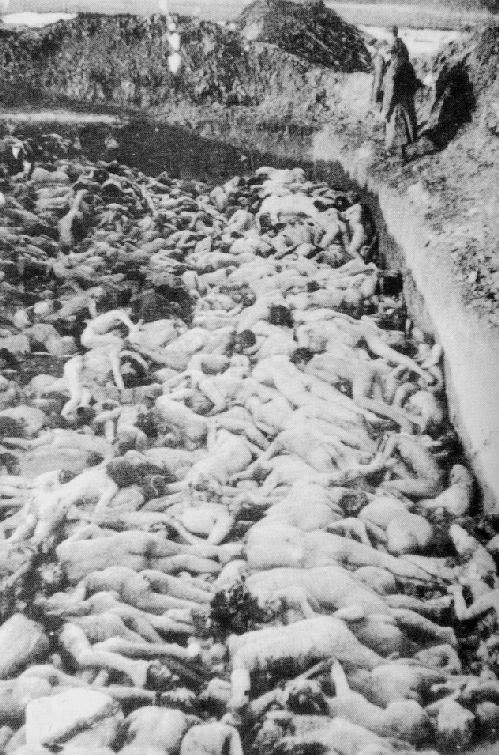
Einsatzgruppe Mass Killing and Grave
The orders coming from Hitler, and signed by Keitel were a “license to kill, although not a great departure from German military traditions….” 147 as I noted in my article about the Legal and Military Foundations of Genocide. The effect of these orders was terrifying, for in a sense the Einsatzgruppen, even when operating with or near the Army “could commit ever crime known to God and man, so long as they were a mile or two away from the firing line.” 148 Additionally the Security Divisions of the Army, which were in charge of rear area security, were “instructed to give material and logistical support to…units of the Einsatzgruppen.” 149 Even worse, other army units in rear areas “could be called on to assist Himmler’s SS police leaders” as the situation dictated, and few commanders refused to honor such requests. 150
Jews Digging their graves.
Adolf Eichmann
For the campaign against the Soviet Union, Himmler had his deputy, SS Obergrüppenfuhrer Reynard Heydrich, the Head of the Sicherheitsdienst or SD, assisted by Heydrich’s SD Deputy, SS-Obersturmbannführer (Lieutenant Colonel) Adolf Eichmann, the SS formed four Einsatzgruppen composed of SD, Waffen-SS and Police troops designated Einsatzgruppen A-D.
SS-Brigadeführer Dr. Franz Walter Stahlecker, Einsatzgruppen A
Einsatzgruppe A was assigned to Army Group North; it was commanded by SS-Brigadeführer Dr. Franz Walter Stahlecker. Stahlecker was killed in action against partisans in early 1942 and was replaced by SS Brigadeführer Heinz Jost.
Einsatzgruppe B was assigned to Army Group Center, and it was commanded by SS-Brigadeführer Arthur Nebe. Nebe returned to his job as Chief of the Kriminal Polizei at the Reichs Security Main Office in October 1941. He was ordered by the head of the Gestapo, SS General Heinrich Müller in the 50 British Officer escapees of Stalag Luft III, the Great Escape for execution in March 1944, and would be involved in the plot to kill Hitler. He went into hiding but was betrayed by a former mistress was arrested and executed at the personal order of Hitler. He was succeeded by SS Brigadeführer Erich Naumann.
Einsatzgruppe C was assigned to Army Group South and was commanded by SS-Gruppenführer Dr. Otto Rasch. Rasch who had been careful to ensure that every officer under his command personally murdered Jews was removed from his position in October 1941 and not returned to service in the SS. Units under his command conducted the Babi Yar Massacre, at Kiev in September 1941. He was employed by a German Oil company until the end of the war. He was a defendant at the Einsatzgruppen Trials but charges were dismissed due to his declining health and inability to take part in his defense. He died in 1948 while in custody. He was followed as commander of Einsatzgruppen C by SS-Gruppenführer und Generalleutnant der Polizei Max Thomas.
Otto Ohlendorf (standing) at the Einsatzgruppen Trial and in Uniform (below)
Lastly, Einsatzgruppe D was assigned to General Erich von Manstein’s 11th Army, which had the responsibility for operations along the Black Sea coast and the conquest of Crimea. It was commander by SS-Gruppenführer Prof. Otto Ohlendorf. During his command his units executed over 90,000 Jews, and at trial he offered no excuses but was brutally honest and unrepentant in what he had done.
The Einsatzgruppen were not standardized in manpower or equipment. In size they were The equivalent of battalions. The largest Einsatzgruppe was Einsatzgruppe A in the North with 990 assigned personnel 151while Einsatzgruppe D was the smallest and had only 550 troops assigned. 152 These units all had SS, SD or Police commanders. Though these units were not large, they also had the support of nine Ordungspolizei battalions, which were initially assigned to the invasion forces to supplement the operations of the Einsatzgruppen. 153
The Importance of the Ordnungspolizei Battalions
The police contingent would grow to be a massive force. By 1943, these Ordnungspolizei battalions would be grouped into regiments and number about 180,000 men assisted by 301,000 local non-German auxiliaries. 154 These units acted in concert with nine Army Security Divisions which handled rear area security. 155
Himmler was so secretive that he initially did not reveal the intent and planned use of the Ordnungspolizei units to the Einsatzgruppen commanders. Instead he told them that they had a “heavy task…to “secure and pacify” the Russian area using Sicherheitspolizei and SD methods.” 156 Understanding the effect of these operations on the Ordungspolizei commanders and their personnel, Himmler told them that “in many cases it is considerably easier to lead a company in battle than to command a company responsible to…carry out executions, to deport people…to be always consistent, always uncompromising-that is in many cases far, far harder.” 157
Russian Jew about to be executed in 1941 by Einsatzgruppe NCO, note the witnesses that include regular Army Personnel
The actions of all of the units are well documented; those of the most notorious, the Einsatzgruppen, but also the active and reserve Ordnungspolizei Battalions, the Army Security Divisions, and other Army or Luftwaffe units that directly aided or supported the killing of the Jews, and the locally recruited Schutzmannschaft battalions 158 which ruthlessly exterminated Jews and others in the operational area. No sooner had an Einsatzgruppe unit entered a city, a “deadly stranglehold” would grip the “Jewish inhabitants claiming thousands and thousands of victims day by day and hour by hour.” 159
Babi Yar
Non-Jewish Russians were encouraged to conduct programs which Heydrich noted “had to be encouraged.” 160 An Einsatzgruppen D report numbered 153 noted: “During period covered by this report 3,176 Jews, 85 Partisans, 12 looters, 122 Communist functionaries shot. Total 79,276.” 161 By the spring of 1942 Einsatzgruppe A had claimed “more than 270,000 victims, the overwhelming majority of whom were Jewish.” 162 The total killed for all groups by early 1942 was 518,388 people, mostly Jews. 163 Germany’s Romanian ally acted against Jews in their operational areas as well. In Odessa, “on 23 October 1941 19,000 Jews were shot near the harbor… probably 200,000 Jews perished either at Romanian hands or after being turned over by the Romanians to the Germans.” 164
To further cloud the ethics and morality, the operations against Jews were often called anti-partisan operations. Himmler referred to Einsatzgruppen as “anti-Partisan formations” 165 while Wehrmacht Security divisions cooperating with the SS “murdered countless Soviet civilians and burned Russian settlements to the ground under the pretext of subduing partisan resistance.” 166 The German attitude in Russia by 1941-1942 was that “all Jews are partisans and all partisans are Jews.” From 1943, all armed resistance was “banditry” and all Jews irrespective of circumstances were treated as “bandits.”” 167
Field Marshal Walter von Reichenau
Field Marshal Von Reichenau, commander of the German 6th Army issued an order in which he stated:
“The soldier in the Eastern territories is not merely a fighter according to the art of war but also a bearer of a ruthless national ideology and the avenger of the bestialities which had been inflicted upon German and racially related nations. Therefore the soldier must have full understanding for the necessity of a severe but just revenge on subhuman Jewry.” 168
Likewise the distinguished Panzer commander, General Herman Hoth issued his own order of 17 November 1941 urging his troops to exact revenge on the Jews and Communists:
“Every trace of active or passive resistance or of any kind of machinations by the Bolshevik – Jewish agitators are [sic] to be immediately and pitilessly rooted out. The necessity of severe measures against elements foreign to people and kind must be understood precisely by the soldiers. These circles are the spiritual pillars of Bolshevism, the tablebearers [priests] of its murder organization, the helpers of the partisans. It consists of the same Jewish class of people which have done so much to harm our Fatherland and by its hostile activity…and anti-culture, which promotes anti-German currents in the whole world and which wants to be the bearer of revenge. Their annihilation is a law of self-preservation. Any soldier criticizing these measures has no memory of the former traitorous activity lasting for years carried on among our own people by Jewish-Marxist elements.” 169
Jews digging their own graves
The commander of the Wehrmacht’s 221st Security Division endeavored to persuade his “subordinate units that the Jews were carriers of Bolshevik contamination and, therefore, the ultimate source of any sabotage or difficulty the division faced.” 170 The extermination of the Jews and partisan war were closely intertwined with the Reich’s economic policies designed to exploit the natural resources of the Russia. This included the “hunger plan” which German authorities seemed to imagine that “millionfold starvation could be induced by requisitioning off all available grain and “shutting off” the cities.” 171

Einsatzgruppe men and Ordungspolizei in action above and below: Yale Historian Timothy Snyder wrote in his book “On Tyranny” wrote: “The European history of the twentieth century shows us that societies can break, democracies can fall, ethics can collapse, and ordinary men can find themselves standing over death pits with guns in their hands. It would serve us well today to understand why.”

The Wehrmacht’s complicity in these measures is demonstrated in the order drafted by Warlimont and signed by Keitel on 13 May 1941. That order, the “Decree on Exercising Military Jurisdiction in the Area of Barbarossa and Special Measures by the Troops” made it clear that international conventions regarding the treatment of civilians would not be observed in the Soviet Union. The order, relying on the historic precedent of German military law in regard to partisan activity stated:
I “Treatment of crimes committed by enemy civilians”
“1. Until further order the military courts and the courts martial will not be competent for crimes committed by enemy civilians.”
2. Francs-tireurs will be liquidated ruthlessly by the troops in combat or while fleeing. “
3. Also all other attacks by enemy civilians against the armed forces, its members, andauxiliaries will be suppressed on the spot by the troops with the most rigorous methods until the assailants are finished (niederkaempfen)”
4. Where such measures were not taken or at least were not possible, persons suspected of the act will be brought before an officer at once. This officer will decide whether they are to be shot. Against localities from which troops have been attacked in or treacherous manner, collective coercive measures be applied immediately upon the order of an officer of the rank of at least battalion etc., commander, if the circumstances do not permit a quick identification of individual perpetrators.”
II. “Treatment of crimes committed against inhabitants by members of the Wehrmacht and its auxiliaries”
1. With regard to offenses committed against enemy civilians by members of the Wehrmacht or by its auxiliaries prosecution is not obligatory, even where the deed is at the same time a military crime or misdemeanor….” 172
Hitler was quite clear in his intent when he told General Halder that in 1941 that he “intended to level Moscow and Leningrad, to make them uninhabitable, so there would be no need to feed their populations during the winter.” 173Economic officials held life and death power over villages. Those that met agricultural quotas were “likely to be spared annihilation and evacuation…the culmination of this process, during 1943, would be the widespread creation of “dead zones.””174
All told during the campaign against the Soviet Union the Einsatzgruppen, Ordnungspolizei, Army, and Local Security killed nearly 1.5 million Russian Jews. 175
Jewish Women Awaiting Execution
By 1942, over two million Soviet POW’s had been killed. 600,000 shot outright, 140,000 by the Einsatzkommandos. 176Eventually about 3.3 million Soviet POWs died in German captivity through starvation, disease and exposure. 177
Most are included included in the total of over 10 million Red Army Combat deaths, but those starved were killed as prisoners, and not in combat, attesting to the inhumanity of their German captors. 178
But still the Jews as an indistinguishable part of the Jewish-Bolshevik menace, were the number one target of the Nazis wherever they went, especially in the Soviet Union. The distinguished German historian Karl Dietrich Bracher wrote, “The reality and irreality of the National Socialism were given their most terrible expression in the extermination of the Jews.” 179
Arthur Nebe, from Jew killer to anti-Hitler plotter
Himmler and others continued to use euphemistic language to describe their efforts talking in terms of “Jewish resettlement.” 180 Terms such as special actions, special treatment, execution activity, cleansing and resettlement were used in place of the word murder. 181At the same time these operations led to problems in the ranks, one SS trooper observed: “deterioration in morale among his own men who had to be issued increasing rations of vodka to carry out their killing orders.” 182
Even commanders of the Einsatzgruppe were affected. Arthur Nebe would say “I have looked after so many criminals and now I have become one myself.” Nebe became an active participant in the July 20th plot against Hitler 183and a fellow conspirator would describe him as a “shadow of his former self, nerves on edge and depressed.” 184 Erich Bach-Zelewski, who led the SS anti- partisan operations, would suffer a nervous breakdown which included “hallucinations connected to the shootings of Jews” which hospitalized him in 1942. 185 Himmler would state in his Posen speech given in October 1943 that “to have gone through” the elimination of the Jews had “and remained decent, that has made us tough. This is an unwritten, never to be written, glorious page in our history.” 186
Proud and Unrepentant: Ohlendorf and Jost on Trial at Nuremberg
While while the Einsatzgruppen, Ordungspolizei battalions, the Wehrmacht Security Divisions, and locally recruited forces continued their Jew Hunts, another even more ghastly plan was being launched against the Jews in Nazi occupied territory. The Endlösung of the Jewish Problem had been set in motion.
To be continued…
Notes
119 Ibid. Megargee. War of Annihilation p.24
120 Ibid. Wheeler-Bennett The Nemesis of Power p.511
121 Ibid. Goerlitz. The Memoirs of Field Marshal Wilhelm Keitel. P.132
122 Glantz, David M. and House, Jonathan. When Titans Clashed: How the Red Army Stopped Hitler. University Press of Kansas, Lawrence, KS. 1995 p.31
123 Trevor-Roper, H.R. Hitler’s Table Talk 1941-1944 with an introduction by Gerhard L Weinberg, Translated byNorman Cameron and R.H. Stevens, Enigma Books, New York, NY 2000. Originally published in Great Britain by Weidenfeld & Nicholoson, London 1953 p.6
124 Ibid. Megargee. War of Annihilation p.10 The campaign against the Soviet Union was to be much more openlyideological as compared to the campaign in Poland.
125 Ibid. Warlimont. Inside Hitler’s Headquarters p.150 126 Ibid. Warlimont. Inside Hitler’s Headquarters p.151
125 Ibid. Warlimont. Inside Hitler’s Headquarters p.150 126 Ibid. Warlimont. Inside Hitler’s Headquarters p.151
127 Ibid. Reitlinger, The SS p.175
128 Ibid. Höhne The Order of the Death’s Head p. 354
129 Ibid. Höhne The Order of the Death’s Head p. 354 Again another deception.
130 Ibid. Warlimont. Inside Hitler’s Headquarters p.153
131 Ibid. Warlimont. Inside Hitler’s Headquarters p.153
132 Ibid. Warlimont. Inside Hitler’s Headquarters pp. 158-159
133 Ibid. Glantz and House. When Titans Clashed p.56
134 Ibid. Davidowicz. The War Against the Jews p.123
135 Ferguson, Niall. The War of the Worlds: Twentieth Century Conflict and the Descent of the West. The Penguin Press, New York, 2006 p.442
136 Ibid. Wheeler-Bennett. Nemesis of Power p.513
137 Ibid. Goerlitz. The Memoirs of Field Marshal Wilhelm Keitel. P.135
138 Ibid. Wheeler-Bennett. Nemesis of Power p.513
139 Hebert, Valerie Genevieve, Hitler’s Generals on Trial: The Last War Crimes Tribunal at Nuremberg University of Kansas Press, Lawrence Kansas 2010 pp.77-78
140 Ibid. Wheeler-Bennett Nemesis of Power p.513 and footnote. He cites the three Army Group commanders, Leeb, Rundstedt and Bock. However Von Rundstedt’s biographer notes that “no evidence exists as to what VonRundstedt’s to this was at the time.” Messenger, Charles, The Last Prussian: A Biography of Field Marshal Gerd Von Rundstedt 1875-1953 Brassey’s (UK) London England 1991. p.134
141 Ibid. Reitlinger, The SS p.176
142 Ibid. Megargee. War of Annihilation p.33
143 Ibid. Warlimont. Inside Hitler’s Headquarters p.162
144 Ibid. Goerlitz. The Memoirs of Field Marshal Keitel p.136
145 Ibid. Goerlitz. The Memoirs of Field Marshal Keitel pp.136-137
146 Ibid. Glantz and House. When Titans Clashed p.56
147 Ibid. Blood. Hitler’s Bandit Hunters p.52
148 Ibid. Reitlinger The SS p. 177
149 Ibid. Shepherd. War in the Wild East p.54
150 Ibid. Reitlinger The SS p. 177
151 Ibid. Rhodes Masters of Death pp.12-13
152 Ibid. Westermann. Hitler’s Police Battalions p.167 153 Ibid. Westermann. Hitler’s Police Battalions p.164 154 Ibid. Blood Hitler’s Bandit Hunters p.141
155 Ibid. Shepherd Wild War in the East p.48. Shepherd notes the deficiencies of these units in terms of organization, manpower and equipment which he calls “far short of the yardstick of military excellence with which the Wehrmacht is so widely associated
156 Ibid. Höhne The Order of the Death’s Head p. 356 Only one of the Einsatzgruppen commanding officers was a volunteer, Arthur Nebe who was involved in the conspiracy to kill Hitler. It is believed by many that Nebe volunteered to earn the clasp to the Iron Cross to curry favor with Heydrich and that initially “Nebe certainly did not know that “employment in the east” was synonymous with the greatest mass murder in history.
157 Ibid. Bracher. The German Dictatorship p.422
158 Ibid. Blood Hitler’s Bandit Hunters p.55
159 Ibid. Höhne The Order of the Death’s Head p. 360 160 Ibid. Friedlander TheYears of Extermination p.207 161 Ibid. Höhne The Order of the Death’s Head p. 360 162 Ibid. Tooze The Wages of Destruction p.481
163 Ibid. Ferguson. The War of the World p.446
164 Di Nardo, Richard L. Germany and the Axis Powers: From Coalition to Collapse. University Press of Kansas,Lawrence, KS. 2005 p.133 The Hungarians would also engage in ant-Jewish operations. Only the Italian army would not conduct operations against the Jews.
165 Ibid. Höhne The Order of the Death’s Head p. 369
166 Ibid. Wette The Wehrmacht p.127
167 Ibid. Blood. Hitler’s Bandit Hunters p.117
168 Ibid. Hebert p.94
169 Ibid. Hebert pp.94-95
170 Ibid. Shepherd. War in the Wild East pp.90-91
171 Ibid. Tooze The Wages of Destruction p.481
172 Ibid, Hebert p.86
173 Ibid. Magargee. War of Annihilation p.64
174 Ibid. Shepherd. War in the Wild East pp.127-128
175 Ibid. Davidowicz The War Against the Jews from the table on page 403. This included 228,000 from the Baltic republics (90%) 245,000 from White Russia (65%) 900,000 from the Ukraine (60%) and 107,000 from Russia proper (11%)
176 Ibid. Rhodes. Masters of Death p.241
177 Ibid. Glantz and House When Titans Clashed p.57
178 Ibid. Glantz and House. When Titans Clashed table on p.292
179 Ibid. Bracher. The German Dictatorship p.431
180 Ibid. Bracher. The German Dictatorship p.430
181 Ibid. Höhne The Order of the Death’s Head p. 367
182 Ibid. Rhodes. Masters of Death p.225
183 Ibid. Rhodes Masters of Death p.225
184 Ibid. Höhne The Order of the Death’s Head p. 363 185 Ibid. Höhne The Order of the Death’s Head p. 363 186 Ibid. Bracher. The German Dictatorship p.423







